
docbass
-
Posts
48 -
Joined
-
Last visited
Content Type
Profiles
News and Information
Tutorials
Product Reviews
Supplier Listings
Articles
Guitar Of The Month
Links and Resources
Forums
Gallery
Downloads
Posts posted by docbass
-
-
The Bennedetto book rocks. However, most archtop boxes are set up for a dovetail style glued in neck... while your neck looks like it's for an electric style set neck... I doubt those two will work together.
Chris
I'm sure they will work together once I trim/cut the heel of the neck to fit appropriately and that's my dilemma. I've not done that before, tough I've worked on set necks before, but have never created one from scratch. That's my interest at this point.
-
OK, I've rehabed/refurbished a number of basses, starting off slowly and building my skills. I have two hollow body/acoustic bodies set up for set necks and two pretty raw necks without fret boards. What's the best book or two around for an amateur builder needing to upgrade his skills in terms of body and neck work on acoustics? Is the Benedetto book a good one for me here?
Here's one of my projects........
body...

neck.........

-
I finally got this done and thought I'd drop back in with pictures. The headstock fix turned out great and the bass sounds fantastic. It's become a favorite.

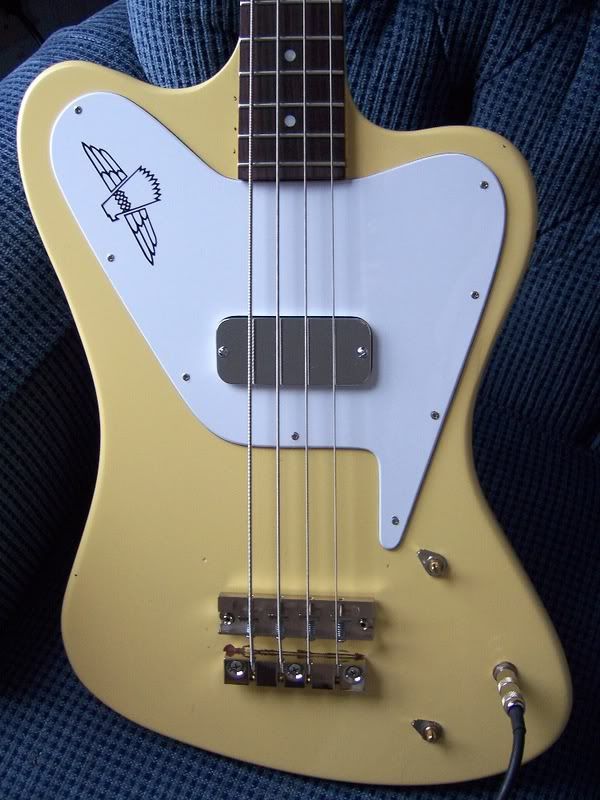
-
So like, if I went back to the front of this topic and copied word for word the first question, would anybody notice? Or even care? Who would get sued, me or Fender?

"Not sure exactly where to put this, but I thought I'd make a post regarding this after reading the thread with the Nuno N4 replica that was being sold on ebay.
Now, please first understand, this is nothing against that auction or how it was listed, this is simply put, a post regarding design theft etc.
I have just completed filing of patents and trademarks for the LGM Leviathan models. This is a brutally expensive process so when somebody goes through the hassles, time and expense of doing it, they expect their design protected.
Under law, once a design is Patented, be it the Leviathan, a Strat, a Les Paul or otherwise, copying that design for more than personal use is completely illegal.
The minute you post pictures you can be held liable for design theft if it can be concluded that you are using those pictures for personal gain, (ie: promotion)
This is not a concern with posting project pictures really because no company is going to spend the money involved in a lawsuit on trying to nail somebody who is attempting to copy a guitar, the exception might be PRS, they seem to try to sue everyone. Well, maybe the Van Halen camp as well.
If you try selling that guitar, you are immediately liable for design theft. You are stealing a patented design plain and simple and looking to profit from it. This includes but is not limited to, trading items for the guitar, even if you sell it for only a penny, it is considered profit reaped from another persons/companies design.
In short, everyone was complaining about that particular auction being fraudulant due to a description that was misleading, making it sound like it was an original guitar, thats true, that's what I thought when I read it as well. However, being a hobby builder for yourself is fine, when you start selling the guitars, be aware of the legal issues you may face. Typically if you're just a small builder there will be no problems, as you become higher profile people start to notice.
This is one of the reasons I designed the Leviathan. Everyone knows I started out by customizing Ibanez's to look like Custom Jem's. I don't want to do that forever and end up in trouble with Ibanez, I have a "handshake" agreement with them (which really doesn't protect me from anything, just an act of good faith) that says I can make custom Ibanez guitars provided I do NOT put "Ibanez" on a non Ibanez neck, never put "JEM" on a guitar that was not originally a JEM, and do not try to ever sell guitars that weren't original Ibanez parts as Ibanez guitars.
That's all fine and good, but now more people are wanting 8 strings and I am not going to build an 8 string that looks like an Ibanez when Ibanez doesn't even have one, hence the Leviathan.
Anyway, this is not in any way meant to discourage anyone. Just to make you aware, if you want to sell your guitars you build on ebay, and they are replica's, remember, the big companies are watching Ebay looking for fraud, that is where you'll start to get in trouble.
Be careful, be smart, and have fun!"
Yep, real funny.

-
no-one, the company with the LICENSE, has paid millions of dollars for the right to use it. And you pay them more per neck, because of that.
So, what if you take a genuine Fender neck, put it on a body that resembles, but is not an exact copy of, a Fender? i.e., the body is obviously not a Fender product when you look at it. What happens when you use old parts to make new creations?
-
In the final stages of refinishing. Using Reranch's vintage cream nitro.

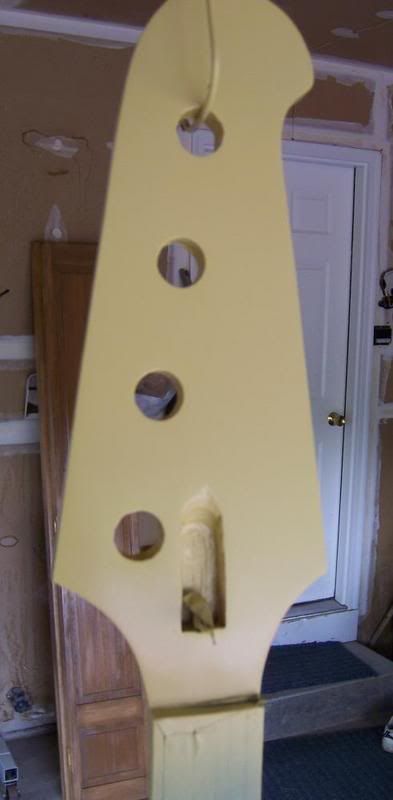
-
That model is a flat top Les Paul bass. The body is essentially the same as the LP guitar, might be a bit bigger, but not by much. This bass is a set neck, 34" scale. Some came with Barts and preamp, some did not. Typical construction was maple on top, mahogany the rest of the body and neck. No binding on these models.
Warmoth makes a nice bass version of this body if you're not ready to build one from scratch.
-
I surface mount quite often and use these E-Z LoK in their #4-40 thread. I slightly enlarge the pickups mounting holes and use Strat intonation screws which are the same thread.
This way of mounting was quite common over the 80's with people like Hamer and Charvel.
Jem
Oh, and if someone's got some of these lying around i've only got 4pcs left and i can't find them in the UK and no US company is willing to sell and ship me just 20-30pcs.
Have you checked with www.rockler.com or www.woodworkersupply.com ? I'm sure one of them has these and will ship to you. I'd be surprised if they didn't.
-
Well, I don't know about the accepted fit for a truss rod, but when I took the old one out of my 60s T-Bird, it was encased in glue that ran down from the maple strip on top of it and was about as tight as you could get. I had to chisel the glue away and still had to tug like crazy to get it out. I guess things have changed since that bass was built!
I had to use a new traditional rod and it went in with light pressure off my fingers. Hammering it in sounds too tight to me as well.
-
Pretty cool man, can't wait to see how you're going to go about the finish.
Yeah, I keep debating with myself. I'm going to try and match the stain first. If that doesn't work, it'll be vintage white )i.e. cream.
-
Tuner holes are done. Now I gotta think about the finish....
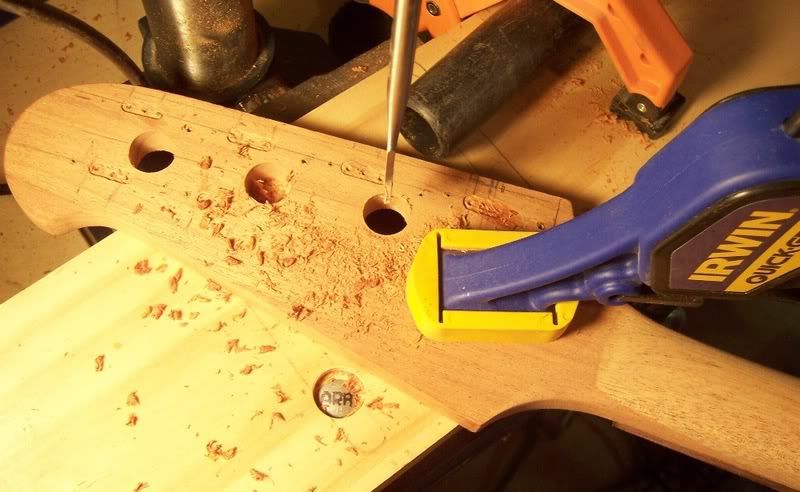
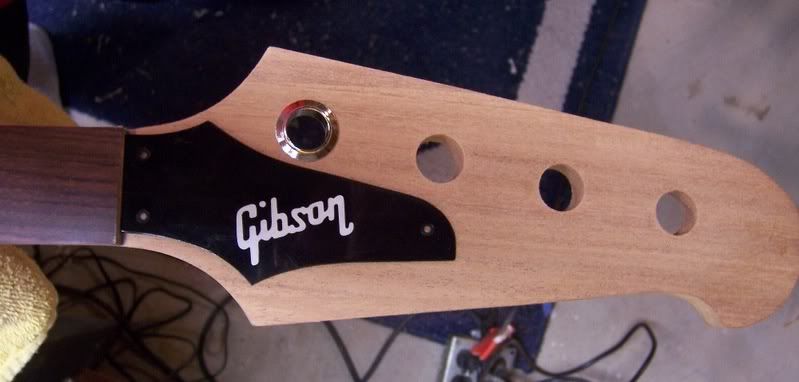
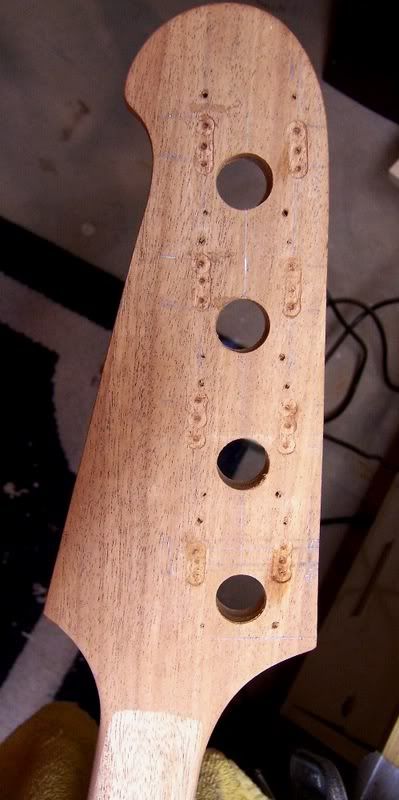
-
Well, for me the most comfortable basses I have are my T-birds. They fit me perfectly, but we're all different! The guitarist in my band only plays Parker Flys, has 5 or 6 of them and swears by 'em.
-
Remember when you're drilling that the forstner bit has a spike in the middle that sticks out further than the main part of the bit. Be careful not to drill too far down as you'll stick the spike through the otherside.
Also remember to remove the bit completely from the wood before trying to move to the next hole...that little spike likes to catch the template & pull you in.
apparently

Thanks for the tips and the warnings!
 I've had my share of mishaps, mostly due to my own lapses of taking care while working on a project. I'm getting better. Making the same replacement part 3 times for a bass sure makes you more skilled and careful!!!!!
I've had my share of mishaps, mostly due to my own lapses of taking care while working on a project. I'm getting better. Making the same replacement part 3 times for a bass sure makes you more skilled and careful!!!!! 
-
Edited: posted in wrong thread! My error.
-
You like? Have another one

Here's the same set of bodies all cleaned up after using the router and template:

Yes, I like! They are beautiful for sure. A picture really does say a thousand words!
-
As others have said, hog the cavity out with a forstner bit, then clean up with a router. You can freehand it for one off designs, or use a template for a cleaner look.

Thanks, great pictures. They really help visual learners like me!!

-
Easiest way, and one of my favorites, is to use a cap on the back of the instrument as well - this can be resawn off the blank if you have the capabilities, allowing you to keep the all-one-piece look, or you can add a veneer in there for a nice accent line, or use wood to match the top. Either way, this way you can just use a saw to cut the chambers through the entire body. (and then you don't make sawdust out of all the wood from the chambers, so you can use it for something else) then glue the back cap on, and you're all set. This method allows you to get the oh-so-cool looking matching cavity covers as well.
Using one piece, I usually hog out the insides with a forstner bit and then clean up with a router as described by the posters above me.
Wow, what a neat idea! I'll have to give that some thought. My saws aren't sufficient to cut the back off but I like the idea of a matching piece on the back.
-
I'd recommend not splining it - you simply don't get the clamping pressure for a good glue joint when using splines, and you have to remove glue joint area from the repaired joint. Same goes for dowels.
When reassembling the joint, look for any little splinters of fragments which can interfere with it going back together perfectly aligned - you may have to remove some 'hairy' sections to get it to fit cleanly. Do this *very* sparingly, and slide it together, and as Doc' says, tap it to final fit with a rubber mallet.
For finish touchup, shellac will go over pretty much everything, and is a good way to even out areas which you need to sand. A light application, rubbed with fine steel wool may work to blend the repair.
Good points and suggestions Setch. I don't use splines either, but I do know some folks do. I didn't use any splines or rods in this repair and it turned out very solid.....
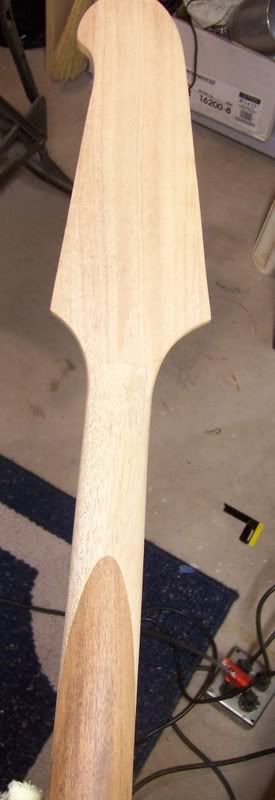
Your scraf joint tips are great too, been using them on my repairs and it works great!
-
I'm repairing a Tobias bass that had it's headstock snapped off after it fell over on the stand.

As you can see from the pictures things could have been much worse. But the joint seems to stick out a bit when pushed together by hand. I'm afraid that after I glue it together I'll have to sand to make everything flush, and I don't know if I'll be able to match the finish (it's some kind of oil finish).
So what is your advice?
First, be careful about pushing the pieces together until you're ready to glue it. It will go back together better with the help of some wood glue as lubricant. When rejoining, you might need to tap it very lightly with a small rubber mallet. I've done that and it's worked before. If the joint is raise, you might have to sand it back a bit.
Second, you might want to put some matching maple strips (tenons) on either side of the headstock midline, in the back, to reinforce the repair. A lot of luthers recommend that technique if you're concerned about the repair stability.
As for finish, I'm sure someone here or in the Guitar Refinishing forum knows that type of finsh Tobias used so you could touch it up.
Those are my best suggestions. I hope someone else chimes in for you.
-
-
I have a solid body blank, alder, 1.75", that I want to chamber and finish with a flame maple top. How do you experienced chaps like to hollow out such a piece? Routers? Forstner bits? Combination of both?
I did a search and came up dry, but know you folks have some preferred methods!
-
Update..........
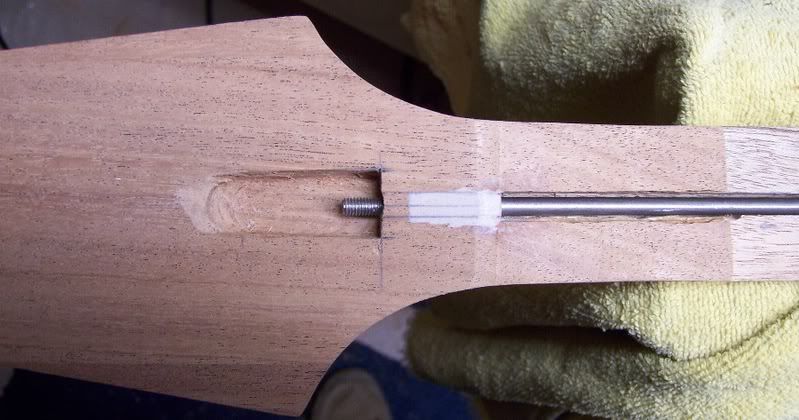
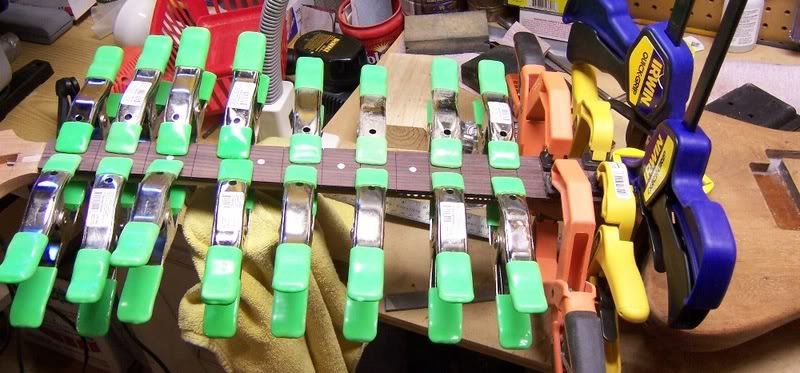
-
Nice Job... I just did that to another SG over the weekend.
Marty
Thanks Marty, it's coming along really nicely now. Your suggestions helped too!
-
I decided to remove the fretboard and patch the neck. It turned out great so far, I've got some final shaping and sanding to do.....
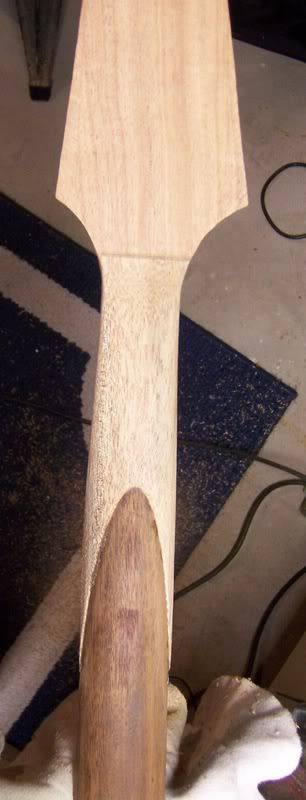
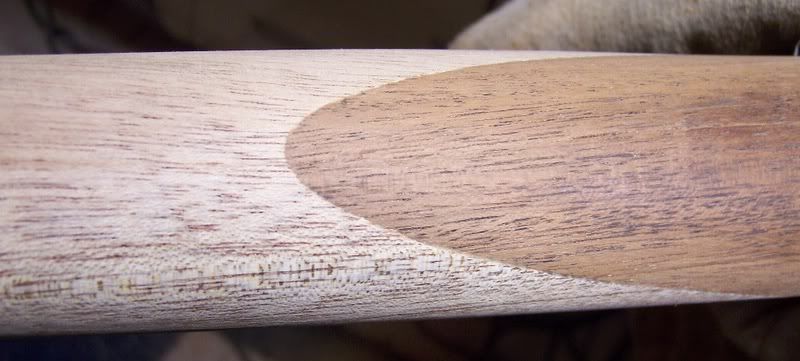


Building/fitting Necks To Acoustic Bass
in Acoustic and Hollowbody Guitar Chat
Posted
Thanks so much Erik, that's the kind of feedback I was hoping for. I am able to craft whatever joint I might need on the neck, the real challenge is getting the neck angle correct with an unfitted neck. I'll definitely look into the Taylor neck idea, although I just remembered that I have a Martin acoustic neck, of the type you described. That might make more sense on this project since it's got a male dovetail routed into it already. I'll have access to the heel from inside the body since there will be a pickup rout at the base of the neck.
I've done some challenging things before and this is just the next step. Here's one I did last year. Missing headstock on a 60's Thunderbird that I recreated from scratch............